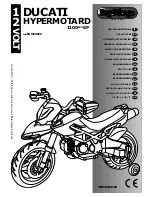
15
KEEPING YOUR DISTANCE
The best protection you can have is
distance — a “cushion of space” —
separating yourself from other vehicles
on the roadway. This will provide you
with a clear view of emerging traffic
situations, so that if someone else
makes a mistake, you will have:
L#<?2A6:2A<?2@=<;1
L#<?2@=.02A<:.;2BC2?6;09B16;4
an escape route if necessary.
Lane Positions
Successful motorcyclists know that
they are safer when clearly seen. In
some ways the size of the motorcycle
can work to your advantage. Each traffic
lane gives a motorcycle three paths of
travel, as indicated in the illustration.
Your lane position should help you:
L
Increase your ability to see and be
seen.
L
Avoid others’ blind spots.
L
Avoid surface hazards.
L
Protect your lane from other drivers.
L
Communicate your intentions.
L
Avoid windblast from other
vehicles.
L
Provide an escape route.
L
Set up for turns.
#.;F:<A<?0F096@A@0<;@612?A52923A
third of the lane – the left tire track of
automobiles – to be their default lane
position. You should then consider
varying your lane position as conditions
warrant, keeping mind that no portion
of the lane need be avoided —
including the center.
You should position yourself in the
portion of the lane where you are most
likely to be seen and you can maintain
a space cushion around you. Change
position as traffic situations change.
Ride in path 2 or 3 if vehicles and other
potential problems are on your left
only. Remain in path 1 or 2 if hazards
are on your right only. If vehicles are
being operated on both sides of you,
the center of the lane, path 2, is usually
your best option.
Remember, the center third of the
lane is the place where debris and oil
drippings from cars collect and where
hazards such as manhole covers are
located. Unless the road is wet, the
LANE POSITIONS
















































